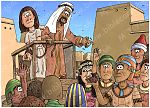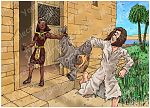Bible Cartoon: Genesis 39 - Joseph in Potiphar's house - Scene 01 - Joseph succeeds
Click on Add to cart button below shopping cart.
Purchased Bible Cartoons do not have watermarks. Links to Cartoons provided on email once purchase is completed.Bible Book: Genesis
Bible Book Code: 0103900101
Scene no: 1 of 2
Bible Reference & Cartoon Description
Genesis 39:1-5 (NLT)
Joseph in Potiphar’s House
1 When Joseph was taken to Egypt by the Ishmaelite traders, he was purchased by Potiphar, an Egyptian officer. Potiphar was captain of the guard for Pharaoh, the king of Egypt.
2 The Lord was with Joseph, so he succeeded in everything he did as he served in the home of his Egyptian master. 3 Potiphar noticed this and realized that the Lord was with Joseph, giving him success in everything he did. 4 This pleased Potiphar, so he soon made Joseph his personal attendant. He put him in charge of his entire household and everything he owned. 5 From the day Joseph was put in charge of his master’s household and property, the Lord began to bless Potiphar’s household for Joseph’s sake. All his household affairs ran smoothly, and his crops and livestock flourished.
DRAWING NOTES:
TIME OF DAY:
Unspecified I the Bible text. I have set this scene in the afternoon.
LIGHTING NOTES:
The sun (high in the sky) illuminates this scene, casting vague shadows below & to the left of figures & objects.
CHARACTERS PRESENT:
From left to right: Potiphar, Joseph, Potaphar’s wife.
RESEARCH/ADDITIONAL NOTES:
This scene shows Potiphar resting on a large cushion chair, in the cool of his house. He has made Joseph his personal attendant. Notice that while Potiphar’s eyes are closed, his wife is reaching out towards Joseph.
I had fun drawing & colouring the mosaic floor of Potiphar’s house, but it took a long time to do!
In the background is the Nile river, with an Egyptian boat being rowed by 6 men, 3 on either side. There is a gravel pathway leading from Potiphar’s house down to the river Nile. Notice the stone man/crocodile statue on a pedestal near the river, which is Sobek (also called Sebek or Sobki, Coptic: Ⲥⲟⲩⲕ, romanized: Souk) who was an ancient Egyptian deity with a complex and elastic history and nature. He is associated with the Nile crocodile or the West African crocodile and is represented either in its form or as a human with a crocodile head (as in my picture).
Here’s the scene without the figures in the foreground.

Background of Genesis 39 – Joseph in Potiphar’s house – Scene 01 – Joseph succeeds
Click on the colour bar below to view/buy this Background:
Background of Genesis 39 – Joseph in Potiphar’s house – Scene 01 – Joseph succeeds
In the sky are 3 Threskiornis aethiopicus (aka African Sacred Ibis), a distinctive large wading bird that measures about 29.5 inches (75 cm in length) and weighs approximately 2.9 pounds (1.35 kilograms). It has a wingspan of 44-48.8 inches (112 to124 cm). The plumage of the sacred ibis is mainly white in colour with black plumes on its lower back. Its small head and slender, curved neck are also black and practically bald. The legs of the sacred ibis are long and black and its feet are partially webbed like most wading birds.
African Sacred Ibis prefers wetlands where it uses its long, slender, downward curved bill to probe into sand and mud in shallow water or in grass and soil when foraging. They are very social birds, nesting in large colonies and feeding in groups of up to 20 individuals. They wade primarily by day catching aquatic prey in shallow waters or probing into the soil with their long beaks for invertebrates. The birds are usually silent and only occasionally make puppy-like yelping noises.
African sacred ibises are carnivores (insectivores, verimivores, molluscivores, piscivores). Their diet consists of mainly insects, worms, crustaceans, mollusks, and other invertebrates, as well as various fish, frogs, reptiles, small mammals, and carrion. They may even eat seeds and in winter sometimes supplement their diet by feeding at rubbish tips.
The African sacred ibises is especially known for its role in the religion of the Ancient Egyptians, where it was linked to the god Thoth.
[Source: https://www.naturespot.org.uk/species/sacred-ibis]





